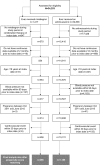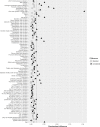Cardiovascular risk profile in individuals initiating treatment for overactive bladder - Challenges and learnings for comparative analysis using linked claims and electronic medical record databases
- PMID: 30325968
- PMCID: PMC6191128
- DOI: 10.1371/journal.pone.0205640
Cardiovascular risk profile in individuals initiating treatment for overactive bladder - Challenges and learnings for comparative analysis using linked claims and electronic medical record databases
Abstract
For managing overactive bladder (OAB), mirabegron, a β3 adrenergic receptor agonist, is typically used as second-line pharmacotherapy after antimuscarinics. Therefore, patients initiating treatment with mirabegron and antimuscarinics may differ, potentially impacting associated clinical outcomes. When using observational data to evaluate real-world safety and effectiveness of OAB treatments, residual bias due to unmeasured confounding and/or confounding by indication are important considerations. Falsification analysis, in which clinically irrelevant endpoints are tested as a reference, can be used to assess residual bias. The objective in this study was to compare baseline cardiovascular risk among OAB patients by treatment, and assess the presence of residual bias via falsification analysis of OAB patients treated with mirabegron or antimuscarinics, to determine whether clinically relevant comparisons across groups would be feasible. Linked electronic health record and claims data (Optum/Humedica) for OAB patients in the United States from 2011-2015 were available, with index defined as first date of OAB treatment during this period. Unadjusted characteristics were compared across groups at index and propensity-matching conducted. Falsification endpoints (hepatitis C, shingles, community-acquired pneumonia) were compared between groups using odds ratios (ORs) and 95% confidence intervals (CI). The study identified 10,311 antimuscarinic- and 408 mirabegron-treated patients. Mirabegron patients were predominantly older males, with more comorbidities. The analytic sample included 1,188 antimuscarinic patients propensity-matched to 396 mirabegron patients; after matching, no significant baseline differences remained. Estimates of falsification ORs were 0.7 (CI:0.3-1.7) for shingles, 1.5 (CI:0.3-8.2) for hepatitis C, 0.8 (CI:0.4-1.8) and 0.9 (CI:0.6-1.4) for pneumonia. While propensity matching successfully balanced observed covariates, wide CIs prevented definitive conclusions regarding residual bias. Accordingly, further observational comparisons by treatment group were not pursued. In real-world analysis, bias-detection methods could not confirm that differences in cardiovascular risk in patients receiving mirabegron versus antimuscarinics were fully adjusted for, precluding clinically relevant comparisons across treatment groups.
Conflict of interest statement
KLG and CRS were working for Astellas Pharma, the project funder, at the time of project completion. SMS and KMJ are employed by Broadstreet Health Economics and Outcomes Research (HEOR). VK is employed by Boston Strategic Partners (BSP). EV and JSR have declared that no competing interests exist. There are no patents, products in development or marketed products to declare. This does not alter our adherence to PLOS ONE policies on sharing data and materials.
Figures
References
-
- Irwin DE, Milsom I, Hunskaar S, Reilly K, Kopp Z, Herschorn S, et al. Population-based survey of urinary incontinence, overactive bladder, and other lower urinary tract symptoms in five countries: results of the EPIC study. Eur Urol. 2006;50(6):1306–14; discussion 14–5. Epub 2006/10/20. 10.1016/j.eururo.2006.09.019 . - DOI - PubMed
-
- Ng D, Shelton J, Wei D, Fan A, Berner T. Retrospective Study Of Utilization Patterns Of Overactive Bladder Therapy In Men In A Commercially Insured Population: The Early Us Mirabegron Experience. Value in Health. 18(3):A189 10.1016/j.jval.2015.03.1093 - DOI
-
- Astellas. MYRBETRICTM Highlights of prescribing information [Product insert]. 2012.
Publication types
MeSH terms
Substances
LinkOut - more resources
Full Text Sources
Medical




